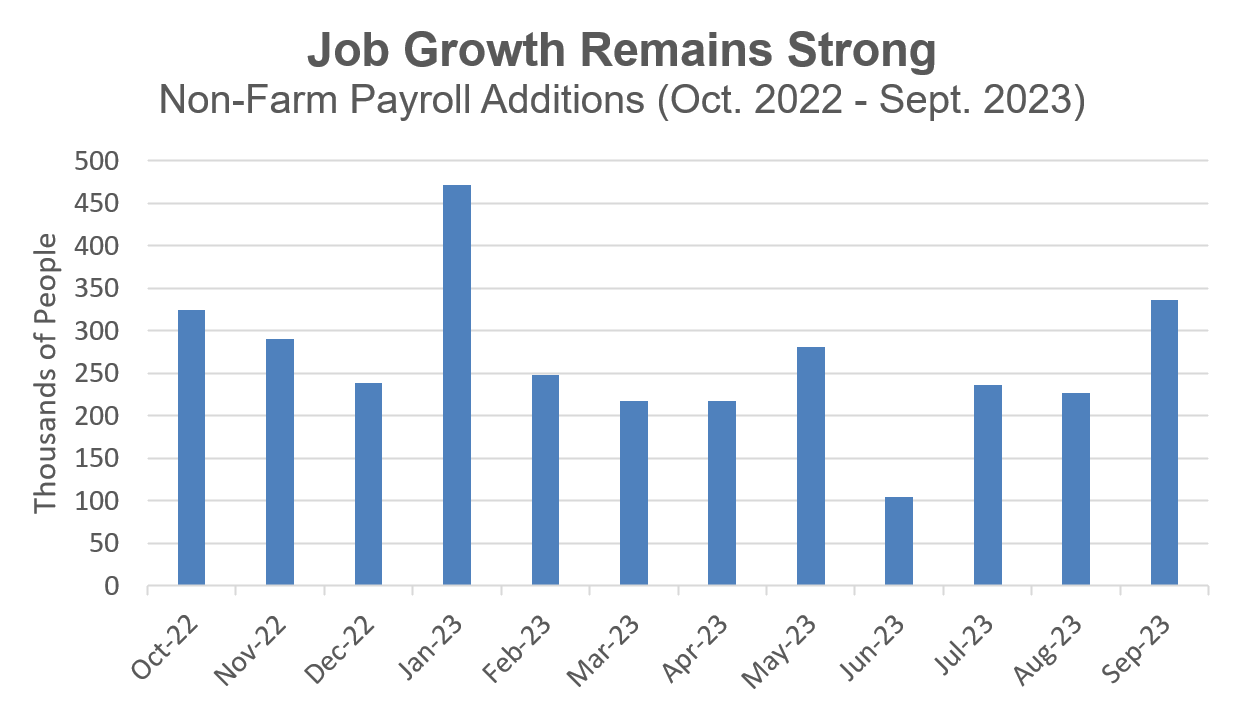Market Monitor: October Mid-Month Update
Headlines and Highlights
- Hamas-Israel war erupts: Diplomatic efforts are in overdrive to avoid a broader Middle East conflict and stem a widening humanitarian crisis after Hamas’ horrific attack on Israeli civilians touched off war. The conflict already has killed thousands. Aside from oil prices initially jumping 4% before falling back, financial markets have so far been relatively unaffected. In trading since the October 7th attack, the S&P 500 has risen 1.5% and the benchmark for international developed markets is up less than 0.1%.
- Global economy remains stable but slow despite U.S. outperformance: The world economy continues to recover from the pandemic and Russia’s invasion of Ukraine but is still just “limping along,” the International Monetary Fund said in its World Economic Outlook. The IMF reduced its growth forecasts for China and the eurozone in slightly trimming its prediction for global real GDP growth in 2024 to 2.9%, down from an estimated 3.0% this year. It cited the “remarkable strength” of the American economy this summer in raising its U.S. forecasts substantially to 2.1% for 2023 (up from 1.8% in July) and 1.5% for 2024 (previously 1.0%) – still modest by historical standards but higher than the average of other advanced economies.
- Labor market displays resilience: U.S. employers added 336,000 jobs in September, far surpassing expectations in a demonstration of companies’ confidence in the face of high interest rates and uncertainty about the economic outlook. Unemployment was unchanged at 3.8%. Hiring had been expected to continue cooling as the Federal Reserve’s interest-rate increases begin to squeeze companies, but September’s results proved otherwise.
Chart of Interest

Hiring spree: The number of U.S. jobs added last month was the second highest in a year.
Sources: U.S. Bureau of Labor Statistics, Altair Advisers
Key Takeaways
- Global tension is high amid war between the Israelis and Hamas, and with Russia and Ukraine dug into an extended war. Markets have maintained their historical tendency to stay stable during military conflicts. Expansion of either war, however, would heighten volatility in stocks and energy prices and pose additional risks for the global economy.
- Markets were mixed at the start of the fourth quarter after a third quarter that saw declines almost across the board. The large-cap S&P 500 added 1% in the first half of October to extend its year-to-date gain to 14.2%. The benchmark for smaller stocks tumbled 4% to go negative for the year. Returns in other asset classes were mixed and little-changed.
- Consumers, tiring of elevated inflation and increased borrowing rates, are expressing increased pessimism in national sentiment surveys while still nudging up their monthly spending as price rises persist. September retail sales rose 0.7% from the previous month, slightly slower than August’s pace.
- Inflation paused its decline in September but there were positive signs of more cooling in the near future. The Consumer Price Index held at 3.7% year over year due in part to a surprising uptick in rent prices. But based on Zillow rent prices that have yet to be tallied in government data, further slowing is coming in housing costs – the biggest remaining factor behind high inflation.
- The Federal Reserve is likely to hold interest rates at the current level of 5.25%-5.5% at its next meeting on November 1st. While Fed officials caution that another increase is possible in December or in 2024 if called for due to changes in the economic outlook, we believe this lengthy rate-hike cycle is probably over.
- Corporate earnings reports for the third quarter got off to a strong start with better-than-expected results by major U.S. banks. S&P 500 companies are forecast to report narrow year-over-year earnings growth for the first time since the third quarter a year ago.
The material shown is for informational purposes only. Forward-looking statements are subject to numerous assumptions, risks, and uncertainties, and actual results may differ materially from those anticipated in forward-looking statements. As a practical matter, no entity is able to accurately and consistently predict future market activities, and all investments are subject to the risk of loss. While efforts are made to ensure information contained herein is accurate, Altair Advisers LLC cannot guarantee the accuracy of all such information presented. Material contained in this publication should not be construed as accounting, legal, or tax advice.
